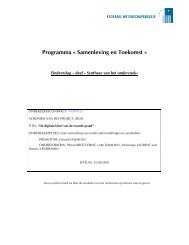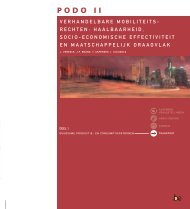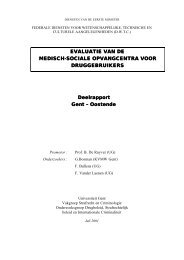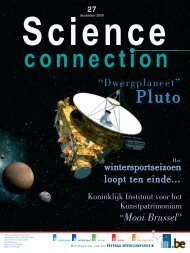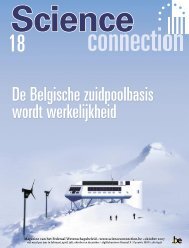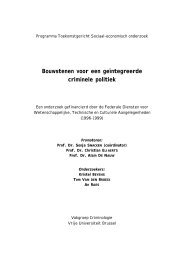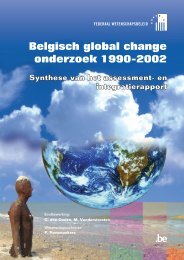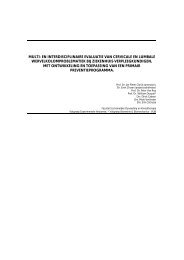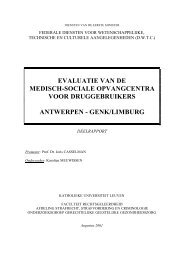chapter 3 inventory of local food systems
chapter 3 inventory of local food systems
chapter 3 inventory of local food systems
You also want an ePaper? Increase the reach of your titles
YUMPU automatically turns print PDFs into web optimized ePapers that Google loves.
Project CP/59 - “Instruments and institutions to develop <strong>local</strong> <strong>food</strong> <strong>systems</strong>”<br />
farmers to build a shorter link with the consumer. Indicators that can be used to measure<br />
this economic impact are for instance the multiplier effect and the impact on the<br />
employment as described before.<br />
1.3.3. Environmental impact<br />
Finally, all environmental impacts within the <strong>food</strong> chain, caused by the human beings,<br />
can be reduced to patterns <strong>of</strong> human consumption (Carlsson-Kanyama et al., 2003).<br />
Food consumption within the household is therefore seen as one <strong>of</strong> the most polluting<br />
or the most resource consuming activities (Carlsson-Kanyama, 1998).<br />
1.3.3.1. Energy consumption for transportation: <strong>food</strong> kilometres or miles<br />
Under ‘<strong>food</strong> kilometres’ we understand the total distance covered by the <strong>food</strong> from the<br />
field to the consumers’ plate. Or: simply the distance between the producer and the<br />
consumer (Jones, 2001). Especially the staggering in space and the intensity with which<br />
products are presently traded has increased considerably, rather than the quantity traded<br />
(Böge, 1995). The number <strong>of</strong> <strong>food</strong> kilometres has increased in the past years mainly<br />
because <strong>of</strong> the increase <strong>of</strong> the international trade, the increase <strong>of</strong> distribution by road,<br />
and the increase <strong>of</strong> the number <strong>of</strong> consumers who go shopping by car (as well as an<br />
increase <strong>of</strong> the distance to the place <strong>of</strong> purchase) (Jones, 2001).<br />
One <strong>of</strong> the main causes <strong>of</strong> the increase <strong>of</strong> international trade has been the relatively<br />
cheap fuel price (www.mcspotlight.org/media/reports/ <strong>food</strong>miles.html). The prices <strong>of</strong><br />
fossil fuels do not reflect the complete costs caused by the consumption <strong>of</strong> these fuels.<br />
The construction <strong>of</strong> roads and vehicles, the environmental damage caused, the costs <strong>of</strong><br />
developing alternative energy sources for the future… are not included in the price (see<br />
also real <strong>food</strong> price).<br />
Food kilometres give a clear image <strong>of</strong> the globalization <strong>of</strong> the mainstream (Western)<br />
<strong>food</strong> system: how far (and how <strong>of</strong>ten) is our <strong>food</strong> transported before it arrives on our<br />
dish? Also, an easy conversion <strong>of</strong> the use <strong>of</strong> fossil fuels and the corresponding emission<br />
<strong>of</strong> greenhouse gases caused by this transport can be made.<br />
When calculating <strong>food</strong> kilometres, only the energy consumption <strong>of</strong> the transport <strong>of</strong> the<br />
<strong>food</strong> is taken into consideration. So, many other things are not included, such as: the<br />
“hidden” kilometres that lie behind it, for instance those <strong>of</strong> the packaging material<br />
separately before it is used as packaging; the harvesting and planting by tractor,<br />
fertilizing and the use <strong>of</strong> pesticides, heating <strong>of</strong> greenhouses, cooling during transport,<br />
conservation and storage, etc.<br />
For instance, Carlsson-Kanyama et al. (2003) demonstrate that in Sweden, less energy is<br />
needed for the import <strong>of</strong> tomatoes from the Canary Island than for tomatoes grown in<br />
Sweden in heated greenhouses. Therefore, it is indicated to also make a complete<br />
analysis <strong>of</strong> the energy consumption throughout the life cycle <strong>of</strong> a product, in order to be<br />
able to make a real environmental comparison between the various chains that bring the<br />
producer close to the consumer. This is placed under the denominator “life cycle<br />
analysis” (LCA).<br />
SPSD II - Part I - Sustainable production and consumption patterns - Agro-Food 20



